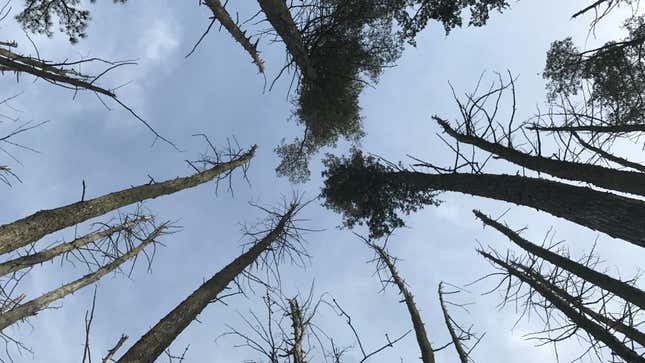
The impacts of climate change are going from spooky to downright scary. A new report chronicles the rise of ghost forests along the East Coast as sea level rise turns soils salty and inundates formerly dry land.
It’s well-documented that the climate crisis is pushing up sea levels and increasing flooding from high tides and sea surges. That’s putting people, infrastructure, and ecosystems at risk. It’s all very scary, but one particularly spooky result of all this is ghost forests, which a new report shows are expanding.
Ghost forests are regions where soils become inundated with saltwater, killing off freshwater-dependent trees and leaving behind trunks which can either become bleached or turn black as they decay. Winds generally blow the trees’ limbs and greenery off their trunks, but once the trunks dry, they can last decades. Eventually, saltwater marsh foliage that can tolerate the salinity such as cord grass grows around the trees.
“They have a ghostly, spectral character,” Richard Lathrop Jr., who directs Rutgers University’s Center for Remote Sensing & Spatial Analysis and was a co-author of the new research, wrote in an email.
The new report, supported by the the Department of Agriculture and published by Rutgers University on Tuesday, looked into what exactly is causing these ghost forests to form and become more common. For the study, the authors analyzed existing scientific literature, interviewed forestry and biology experts, and also held a convening of scientists last January.

They found that the main culprits are effects of the climate crisis, including rising, salty tides surging amid storms and heavy rain spells, both of which inundate soils. As both worsen along the East Coast, more coastal forest land from Virginia through Massachusetts is taking on these ghostly traits. The findings show that the line where the marsh meets the forest is pushing inland. In the Chesapeake Bay region, that’s been happening at about 1.6 feet (0.5 meters) per year for the past 100 years, though some areas have seen the transition happen at rates up to 20 feet (6 meters) per year. But it’s hardly isolated to that region.
“This is happening up and down the East and Gulf Coasts, especially in coastal areas where there is low lying, gently sloping land adjacent coastal bays,” said Lathrop.
Ghost forests aren’t just expanding due to the effects of the climate crisis, they could also be making the climate crisis worse, creating a vicious feedback loop. The forests of the mid-Atlantic and New England are currently important carbon sinks, especially because they’re home to many evergreen trees which photosynthesize—or breathe carbon dioxide in and exhale oxygen—for more months of the year than other trees. Forests soils also absorb carbon, but that effect is lessened when they get flooded with water.
“One ecological benefit of healthy coastal forests is the sequestration and storage of carbon both aboveground and in soils,” Lindsey Smart, a a research associate at the North Carolina State University who studies ghost forests but didn’t work on the new report, said in an email. “As coastal forests transition to marsh, we lose aboveground carbon. Some of that is released into the atmosphere and some shifts to other carbon pools.”
There are other troubling ecological effects of the expansion of ghost forests, too. The coastal forests which the study examined provide a home for a vast array of uncommon plants and wildlife, including rare birds, swamp pink plants, and cypress swamp sedge flowers. Since these forests’ soils are also able to soak up rains, they also buffer people who live inland from floods caused by coastal storms.
To stop this degradation of coastal forest ecosystems, the authors call on the U.S. to more carefully plan how land is used. That includes protecting coastal forest from development—likely a bad idea anyway, considering the threat of floods—by bringing more of it under federal protections. Officials could also go even further by facilitating the expansion of forests into areas that are farther away from coasts, planting more trees where the soil is less drenched and the threat of incoming tides and storm surges is lower. They could also plant more forest vegetation that better tolerates changing conditions in soil salinity and wetness.
Smart noted that as it undertakes these conservation strategies, the government will also need to work with landowners, “given that much of the coastal landscape is in private hands.”
In fact, 77% of the country’s private forestland is in the eastern part of the country. Promoting these strategies could be a useful form of climate adaptation for many parts of the country which are seeing their forests become more ghostlike.
“This study adds to the growing evidence that this is not a localized phenomenon, given other reports up and down the east coast,” said Smart. “While the rate and extent varies based on local site characteristics, it’s clear that sea level rise and the synergistic pressures between sea level rise and land use modification...are changing our coasts, impacting our coastal forests.”